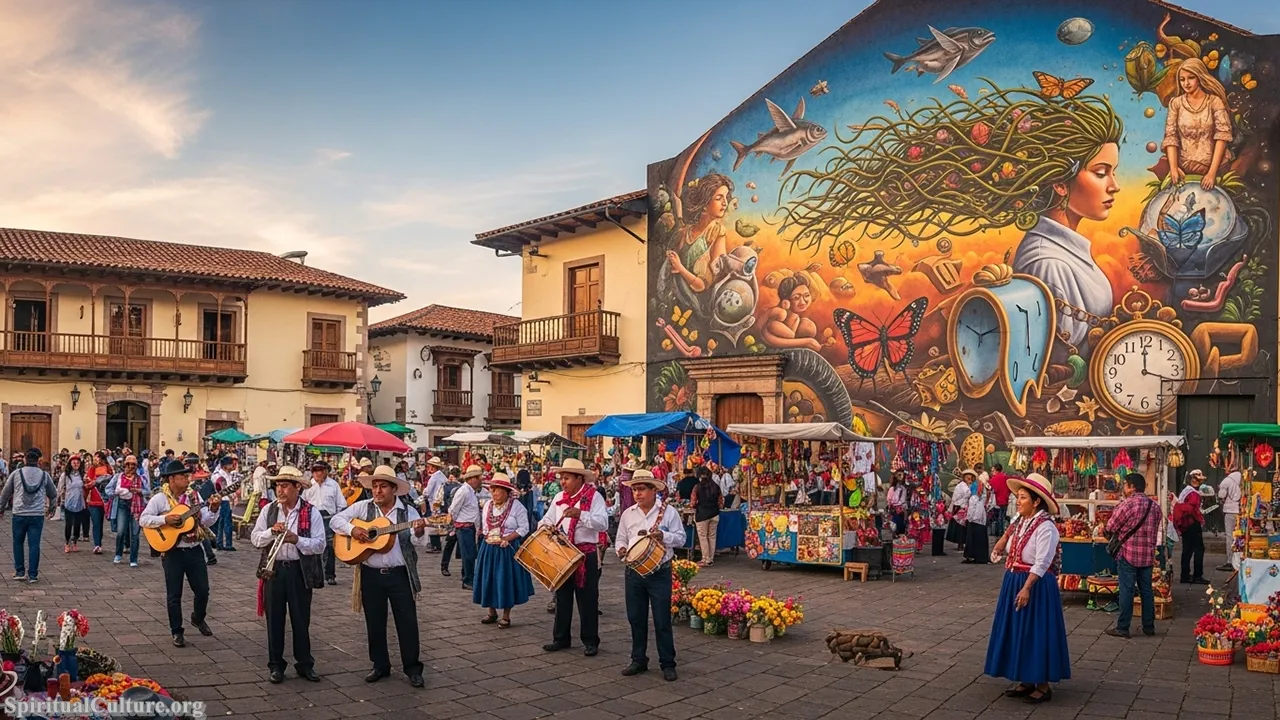Language is the ultimate vessel of human heritage, serving not merely as a tool for communication but as the architecture of thought, tradition, and spiritual expression. It is the repository of our deepest philosophical insights, the carrier of our sacred texts, and the DNA of our collective cultural identity. In the sphere of Spiritual Culture, a language’s true influence extends far beyond the number of its native speakers, reaching into the historical depth of its literature, its foundational role in major religions, and its capacity to shape global thought across centuries.
This Top 10 guide delves into the linguistic titans that have profoundly shaped global civilization. We prioritize languages that have demonstrated exceptional endurance and diffusion—those that codified major world religions, underpinned vast historical empires, or currently serve as the indispensable bridge for international commerce and technological diffusion.
The rankings below are constructed based on a reasoned, evidence-based cultural criterion that weighs spiritual and historical significance (e.g., the presence of ancient, canonical texts) alongside contemporary global reach (e.g., total speakers, internet content volume) as of the Current Time of Writing, providing an insightful perspective on linguistic supremacy in the realm of culture and spirit.
Table of the Top 10 Most Influential Languages in Global Culture and Spirituality
| Rank | Language | Primary Spiritual/Cultural Impact | Total Speakers (Approximate L1+L2, Current Time of Writing) |
|---|---|---|---|
| 1 | English | Global Lingua Franca, Science, Technology, and Modern Media. | ~1.5 Billion |
| 2 | Mandarin Chinese | Historical Eastern Philosophy (Confucianism/Taoism), Contemporary Economic and Media Power. | ~1.2 Billion |
| 3 | Arabic | Language of Islam (The Quran), Preserver of Classical Knowledge, Medieval Science. | ~300 Million (Modern Standard Arabic L2 is significant) |
| 4 | Spanish | The Cultural Spine of Latin America, Vast Literary Tradition, Global Diaspora. | ~560 Million |
| 5 | Sanskrit | Foundational Language of Hinduism, Buddhism, Jainism, and Ayurvedic Science. | Largely ceremonial/scholarly (Classical Language) |
| 6 | Latin | Language of the Roman Empire, Roman Catholicism, Western Law, and Scientific Taxonomy. | Largely ceremonial/scholarly (Classical Language) |
| 7 | Hindi | The Linguistic Anchor of Modern India, Bollywood Film Industry, and South Asian Diaspora. | ~610 Million |
| 8 | French | Historical Language of Diplomacy and Enlightenment Philosophy, Francophone Cultural Network. | ~310 Million |
| 9 | Japanese | Cultural Export (Manga, Anime), Technological Innovation, Shinto/Zen Buddhist Texts. | ~126 Million |
| 10 | German | Language of Classical Philosophy (Kant, Hegel), Music (Goethe, Nietzsche), and European Academia. | ~130 Million |
#10. German 🇩🇪
German holds its place in this list not due to sheer speaker numbers, but through its irreplaceable legacy in Western intellectual and academic history. It is the language of the great philosophical movements of the 18th and 19th centuries, the medium through which thinkers like Kant, Hegel, and Nietzsche articulated transformative ideas on human consciousness, morality, and existence. As of the Current Time of Writing, German remains essential in fields like engineering, science, and classical musicology, underscoring its profound, albeit specialized, cultural weight across Europe and the globe.

The reason for ranking German is its intense spiritual impact on modern secular and moral philosophy, an influence disproportionate to its geographical spread. It served as the primary language for the Enlightenment in Central Europe and for Romanticism, fundamentally altering the way the West approached questions of truth, beauty, and the nature of the self. The works of composers and poets, from Goethe to Beethoven, enshrined in German, continue to move and shape cultural sensibilities globally.
To study German is to engage directly with the wellspring of modern European thought, offering a vital moral lesson in the power of concentrated academic rigor. The precision and complexity of the German language often mirrors the depth and systemic thought required for true spiritual and intellectual exploration, reminding us that influential culture is often born from profound internal discipline and critical inquiry.
Cultural/Spiritual Highlights
- The primary language of the Continental Philosophy tradition.
- Source language for influential texts on Protestant Theology and the Reformation.
- Dominant medium for classical European musicology and literature (e.g., Goethe, Bach).
- Crucial for specialized engineering and scientific research globally.
#9. Japanese 🇯🇵
Japanese is an influential language rooted in a deeply unique and highly preserved culture. While its nearly 130 million speakers are geographically concentrated, its cultural output—particularly in the forms of film, video games, manga, and anime—has permeated global popular culture, creating a vast and passionate international following as of the Current Time of Writing. Furthermore, the complexity and distinct aesthetic of the language itself, utilizing three scripts (Hiragana, Katakana, Kanji), reflects an intricate, detail-oriented worldview that fascinates millions worldwide.

The spiritual impact of Japanese is subtle yet potent, largely channeled through the traditions of Shinto and Zen Buddhism. Concepts like Wabi-Sabi (finding beauty in impermanence and imperfection) and the connection between humans and nature, fundamental to the Japanese aesthetic, have been disseminated through its art and media, influencing design, mindfulness, and spiritual practice across the West. Its cultural influence acts as a modern-day bridge to ancient Eastern spiritual philosophy.
The global admiration for Japanese culture highlights the preservation value of maintaining a distinct and rich cultural-linguistic identity in the face of globalization. It teaches a moral lesson in honoring ancestral tradition while fearlessly innovating—the classical language of Zen poetry is also the language of cutting-edge technology and global digital entertainment.
Cultural/Spiritual Highlights
- Vehicle for the global spread of Zen Buddhist aesthetics and practice.
- The linguistic foundation for a multi-billion dollar global media export industry.
- Its writing system (Kanji) reflects ancient Chinese philosophical concepts.
- Central to the philosophy of Wabi-Sabi and traditional Japanese arts (e.g., Haiku).
#8. French 🇫🇷
French maintains an elevated status on the global cultural stage due to its immense historical role as the language of diplomacy, high culture, and intellectual discourse for centuries. With over 300 million speakers across 29 countries, it anchors a vast Francophone world spanning Europe, Africa, and North America. As of the Current Time of Writing, its use continues to be vital in international organizations like the UN and the IOC, a legacy of its past dominance as the ultimate cultural lingua franca.

The spiritual impact of French is inextricably linked to the Enlightenment, the period that birthed modern democratic and humanistic values. The language was the medium for the revolutionary ideas of liberty, equality, and human rights, articulated by philosophers like Rousseau and Voltaire. This literary and philosophical tradition provided the intellectual framework for multiple revolutions and the subsequent rise of modern secular governance, a profound, human-centric spiritual movement.
The reflective value of French lies in its enduring association with clarity, elegance, and humanist thought, a celebrated characteristic known as clarté française. It offers a celebration of reasoned discourse as a tool for moral and societal improvement, encouraging appreciation for precision in language as a necessary step toward precision in thought and spiritual insight.
Cultural/Spiritual Highlights
- The language that formalized modern Diplomacy and international law.
- The primary medium for the Enlightenment’s political and philosophical texts.
- Anchors the Francophonie, a global cultural and political community.
- Dominant language in fields of Art Criticism, Culinary Arts, and fashion.
#7. Hindi 🇮🇳
Hindi is one of the most widely spoken languages in the world, serving as the official language of India and a crucial link across the diverse linguistic landscape of the South Asian subcontinent. With its total speakers exceeding 600 million, its demographic weight and growing economic significance make it an undeniable force in the 21st century. As of the Current Time of Writing, Hindi’s influence is amplified by its role as the language of Bollywood, which consistently produces more films than any other industry globally, projecting Indian culture and spiritual themes to a massive international audience.

Its spiritual impact is profound, as it is a direct descendant of Sanskrit and retains deep connections to the Bhakti traditions of devotional poetry and music. Hindi’s literature and its use in popular media are imbued with the ethical and moral narratives drawn from foundational Hindu epics. This daily, popular dissemination of ancient spiritual lessons via cinema and song allows its cultural influence to reach far beyond national borders, connecting the South Asian diaspora and engaging global viewers with themes of duty (Dharma), love (Prema), and familial harmony.
The moral lesson of Hindi lies in its powerful role in national integration amidst extraordinary diversity. As a language that bridges countless dialects and regional languages, it celebrates a unity of spirit—a spiritual and cultural syncretism—that is foundational to the identity of India, teaching the world a crucial lesson in co-existence and mutual understanding.
Cultural/Spiritual Highlights
- The primary language of the Bollywood film industry, a major cultural export.
- A direct descendant of Sanskrit, retaining deep spiritual and lexical roots.
- Vehicle for widespread Bhakti (devotional) literature and poetry.
- One of the official languages bridging the vast linguistic diversity of India.
#6. Latin 🇮🇹🇻🇦
Latin, though considered a “dead” language with no native speakers as of the Current Time of Writing, is functionally immortal, remaining the cornerstone of Western civilization. It was the official language of the Roman Empire, which shaped the laws, administration, and infrastructure of Europe for a millennium. Even today, it is the official language of the Vatican City and the traditional language of the Roman Catholic Church, a spiritual institution with over a billion adherents globally.

The spiritual impact of Latin is vast, having served as the primary language of the Western Christian Church for over 1,500 years, codifying its doctrine, liturgy, and theological scholarship. Furthermore, it provided the lexicon for all Western legal and governmental systems and remains the source for scientific taxonomic nomenclature (e.g., biological classification). This foundational role in law, religion, and science means Latin’s influence is implicitly woven into the fabric of modern, Western thought and culture.
The preservation value of Latin lies in its function as a time capsule, offering direct access to the moral and legal philosophies of antiquity and the foundational spiritual texts of the West. It teaches the lesson that the structures we build—be they intellectual, legal, or spiritual—often require a common, enduring vocabulary to stand the test of time, urging a celebration of history’s steady, profound contributions.
Cultural/Spiritual Highlights
- The official liturgical language of the Roman Catholic Church (Vatican).
- The root language for all Romance Languages (e.g., Spanish, French, Italian).
- The language of Western Law and political philosophy (e.g., Corpus Juris Civilis).
- Source of nearly all modern scientific and biological classification.
#5. Sanskrit 🇮🇳
Sanskrit is not a language of millions of daily speakers in the Current Time of Writing, but it is a Classical Language whose cultural and spiritual footprint is arguably wider and deeper than almost any other. It is the sacred language of Hinduism and a cornerstone of Indian civilization, with its roots dating back to the Vedic period (c. 1500 BCE). It is the meticulously structured language that birthed vast intellectual traditions in philosophy, linguistics, and mathematics, influencing all major modern languages of the Indian subcontinent.

The spiritual impact of Sanskrit is immeasurable: it is the language of the Vedas, the Upanishads, the Bhagavad Gita, and the Yoga Sutras. These texts form the spiritual and philosophical bedrock for billions of people globally, influencing practices from meditation to mindfulness. The very sound of its mantras is considered spiritually potent and capable of invoking higher consciousness, illustrating a profound reverence for the language itself as a sacred conduit to the divine.
The moral and preservation value of Sanskrit is the insight it gives into the perfect harmony between language and spiritual knowledge. Its sophisticated grammatical structure (codified by Pāṇini) is celebrated by modern linguists, suggesting that true spiritual thought requires a language of profound clarity and internal logic. It stands as a celebration of eternal wisdom, untouched by the flux of daily parlance.
Cultural/Spiritual Highlights
- The sacred and liturgical language of Hinduism and Vajrayana Buddhism.
- The language of all major Yoga and Vedantic philosophical texts.
- The source and inspiration for a majority of Indo-Aryan languages (including Hindi).
- Celebrated by linguists for its perfectly logical grammatical structure (Pāṇini).
#4. Spanish 🇪🇸🇲🇽
Spanish is an undisputed global titan, possessing over 560 million total speakers and ranking second globally in native speakers, spread across 21 countries in Europe, the Americas, and Africa. As of the Current Time of Writing, its status as the cultural spine of Latin America and its significant presence in the United States give it tremendous, growing cultural and economic influence. The language provides a unifying thread for an incredible variety of distinct, vibrant national cultures, from the Andes to the Iberian Peninsula.

The spiritual impact of Spanish is primarily tied to the global diffusion of Catholicism following the Age of Exploration, serving as the linguistic medium for the faith across vast territories. Culturally, it is the language of a staggeringly rich literary tradition—the language of Cervantes, Gabriel García Márquez, and the surrealist movements that defined the 20th century. Its artistic and philosophical depth continues to shape global narratives on identity, history, and magical realism.
The reflection offered by Spanish is one of resilience and immense cultural synthesis. It is a language that carries the complex historical weight of indigenous, European, and African influences, teaching a lesson in how spiritual and cultural expression can not only survive but thrive by adapting and integrating diverse worldviews into a single, cohesive linguistic banner.
Cultural/Spiritual Highlights
- Vehicle for the global spread of Catholicism throughout the Americas.
- The language of the Magical Realism literary movement and its spiritual themes.
- Lingua franca for the massive and growing Hispanic diaspora globally.
- Official language in 21 countries, spanning four continents.
#3. Arabic 🇸🇦🇪🇬
Arabic holds an unassailable position due to its historical and religious authority. It is the language of the Arab world, with hundreds of millions of speakers across the Middle East and North Africa, and, crucially, it is the liturgical language of Islam. As of the Current Time of Writing, with nearly two billion Muslims worldwide, Arabic has a profound and permanent spiritual significance that touches nearly a quarter of the global population, far outweighing its native speaker count.

The spiritual impact of Arabic is singular: it is the sacred language in which the Quran was revealed. For every Muslim, recitation of the Quran in Arabic is the highest form of worship, lending the language an unparalleled spiritual reverence. Historically, during the Golden Age of Islam, Arabic was the primary language of science, philosophy, and mathematics, acting as the intellectual preserver and disseminator of Greek, Persian, and Indian knowledge, which was vital to the European Renaissance.
The profound lesson Arabic offers is the immense power of a language to unify disparate peoples under a common spiritual and intellectual banner. It is a celebration of intellectual stewardship, showcasing how a language can bridge continents, preserve ancient knowledge, and serve as the immutable, sacred conduit for a global faith.
Cultural/Spiritual Highlights
- The sacred language of the Quran and the liturgy of Islam.
- The historical language of Medieval Science, Philosophy, and Mathematics.
- The cultural unifier for the vast and politically significant Arab World.
- A major working language of the United Nations and international diplomacy.
#2. Mandarin Chinese 🇨🇳🇸🇬
Mandarin Chinese is the most widely spoken language by native speakers in the world, with approximately 1.2 billion total speakers, primarily concentrated in the People’s Republic of China, which holds massive economic and demographic influence in the Current Time of Writing. Its ideographic writing system, Hànzì, has served as a cultural bridge across East Asia for millennia, influencing the scripts of Japanese, Korean, and Vietnamese. Mandarin’s rising global stature is a direct reflection of China’s economic ascendance and burgeoning cultural soft power.

The spiritual impact of Mandarin is deeply historical and philosophical. It is the language through which the tenets of Confucianism, Taoism, and Classical Chinese Buddhism are expressed and studied. The unique structure of its characters often conveys profound philosophical concepts, where the written word itself acts as a meditation on meaning. The language is the repository for ancient wisdom texts, traditional arts, and historical records that define the world’s most enduring continuous civilization.
Studying Mandarin offers a moral reflection on the long arc of civilization and the power of continuity. It celebrates the wisdom of a culture that values historical memory and the profound complexity inherent in its characters, teaching that true influence is built not overnight, but over thousands of years of persistent philosophical and cultural refinement.
Cultural/Spiritual Highlights
- The language of Classical Chinese Philosophy (Confucianism and Taoism).
- The most widely spoken language by native speakers globally.
- Its logographic script is a primary cultural touchstone across East Asia.
- The key linguistic tool for engagement with a rising global economic power.
#1. English 🇺🇸🇬🇧
English stands as the most influential language in global culture as of the Current Time of Writing, functioning as the world’s undisputed global lingua franca. With approximately 1.5 billion total speakers—the highest of any language—its dominance is defined less by native count (which is surpassed by Mandarin) and more by its staggering number of second-language speakers (over 1.1 billion) and its centrality to the global infrastructure. It is the default language of international commerce, air travel, science, technology, and, critically, over 60% of the internet’s content.

The spiritual impact of English is that of a universal connector. It acts as the primary medium for cross-cultural exchange, allowing scholars, spiritual leaders, scientists, and artists from all nations to share ideas, research, and cultural products instantly. While it lacks a single, ancient sacred text of its own, it has become the most common access language for the world’s diverse spiritual and philosophical texts. It is the language of modern humanistic ideals, global advocacy, and the widespread dissemination of democratic principles.
The moral lesson of English is the transformative, synthesizing power of accessibility. It celebrates the ability of a language to evolve into a global, neutral medium, teaching the spiritual value of breaking down cultural and geographic barriers for the sake of shared knowledge and mutual understanding. English is the ultimate reflection of a truly globalized, interconnected culture.
Cultural/Spiritual Highlights
- The Primary Lingua Franca of science, aviation, commerce, and diplomacy.
- The language of the vast majority of Internet content and software development.
- The main cultural engine for global popular culture (film, music, literature).
- The language with the highest number of second-language (L2) speakers globally.
Conclusion
Our journey through the Top 10 Most Influential Languages in Global Culture reveals that a language’s true power is a synthesis of historical depth, spiritual authority, and contemporary accessibility. While the ancient languages like Sanskrit and Latin serve as foundational spiritual reservoirs, and Arabic as an enduring religious conduit, it is the modern behemoths like Mandarin Chinese and, above all, English that currently govern the global cultural conversation.
At Spiritual Culture, we celebrate these languages not as mere communication systems, but as living, breathing monuments to human achievement. Each language is a unique worldview, a precious vessel carrying the accumulated wisdom, moral lessons, and spiritual insights of its speakers. To recognize their influence is to honor the profound, interconnected tapestry of our global cultural heritage, ensuring that the legacy of these linguistic titans is preserved and appreciated by generations to come.





